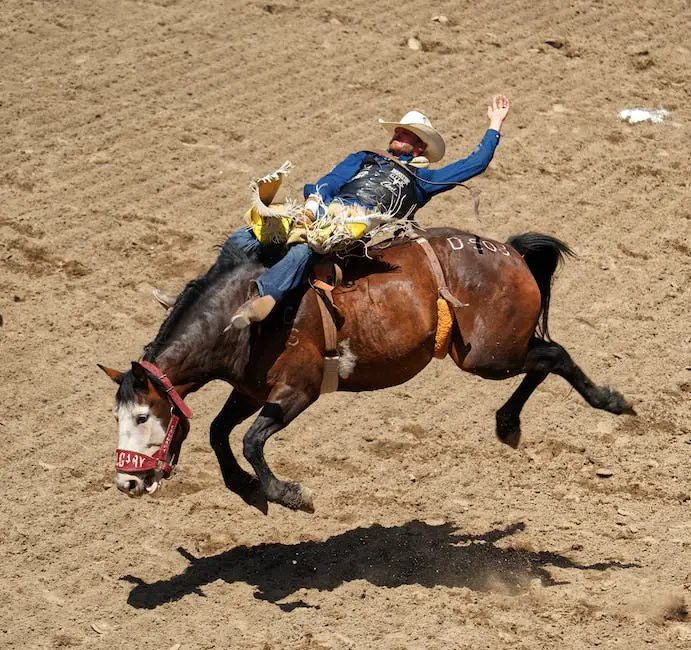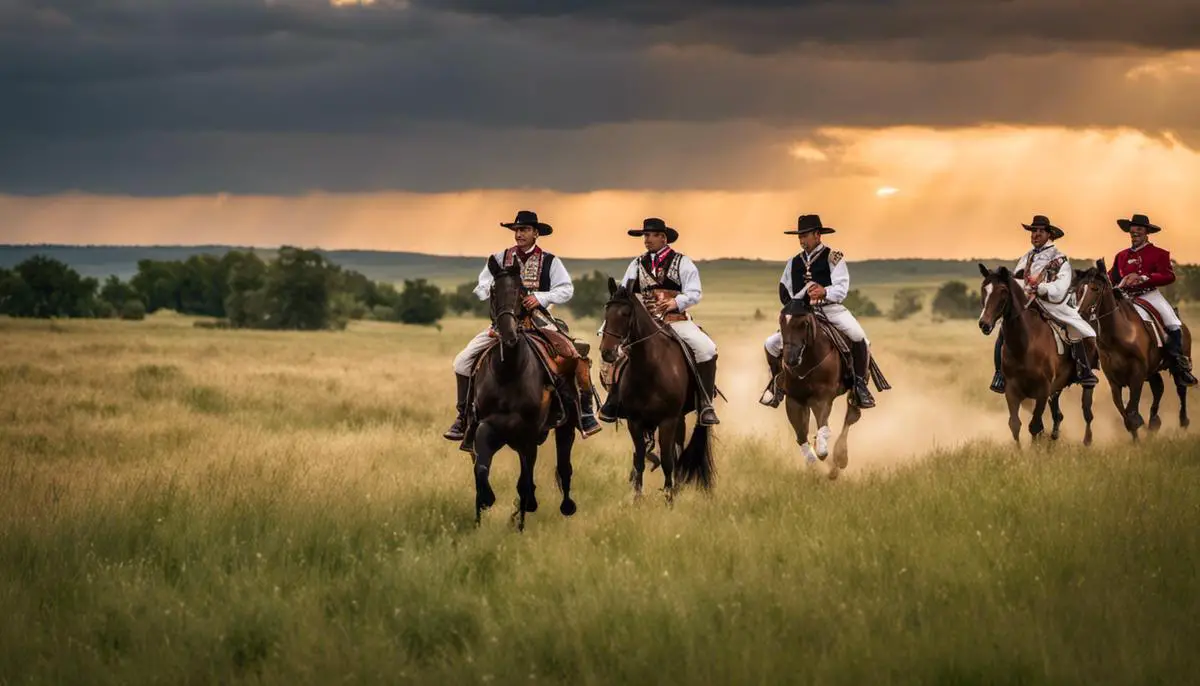Imbued with a rich history stretching back a thousand years, the Hungarian cowboy or csikos culture offers a fascinating glimpse into a different era where man and nature converse to create a harmonious rhythm of life. Originating from the vast grasslands region called Puszta, Hungarian cowboys have masterfully maintained their traditional lifestyle, braving societal and geopolitical challenges, and preserving traditions that hark back to centuries. From the daily tasks enveloped in their enthralling puszta life to their distinctive attire that narrates a cultural story, the csikos culture is a testament to the tenacious flairs of humanity to preserve its cherished heritage. This remarkable culture has not only survived the passage of time but has also transcended international borders, captivating audiences around the globe with its unique charm.
Table of Contents (Horspedia)
Historical Origins
Origins of the Hungarian Csikós
The Hungarian cowboy, known as the csikós, can trace its origin back to the Magyars, the original Hungarian ethnic group that settled in the Carpathian basin in the 9th century. They were primarily a horse-riding warrior society, and their horse taming and rearing skills were quickly recognized and adopted by other European nations. Much of modern Hungarian cowboy culture is built around a romantic image of those early Magyars, and their love for wild, free horses.
Role of the Csikós
The primary role of the csikós was caring for the Noniusz breed horses, large and durable animals imported from France during the early 19th century and ideal for agricultural work. Looking after large herds of horses on the open plains required the development of a variety of skills and capabilities. In addition to their herding duties, the csikós were also responsible for training young horses and keeping the genetic traits of the herds.
Life on the Puszta
The puszta is a vast grassland region in Hungary where the csikós lived in harmony with nature. They were the epitome of self-sufficiency, relying on their skills and knowledge to survive in those barren landscapes. Their homes were simple, often only single-roomed thatched cottages known as “szállás.” The csikós diet was basic, consisting of staples like bread, lard, bacon, and occasionally some freshwater fish caught in the local rivers or ponds.
Traditional Csikós Dress and Equipment
A csikós traditional attire was both functional and remarkable with its bright blue color. The outfit included pants tucked into knee-high boots, a decorated broad-brimmed hat for sun protection, a linen shirt under a short fur-lined waistcoat, and a sheepskin coat for colder weather. Csikós also equipped themselves with several tools, including a long whip, known as an ostor, and a lasso.
Csikós Culture in the Modern Era
Modern Hungary has made concerted efforts to preserve the Hungarian Cowboy culture amidst urbanization and globalization. Csikós traditions are showcased during various festivals, live performances, and in Hungarian folk art. In Hortobágy National Park, tourists can observe csikós as they perform amazing horse tricks and demonstrate their equestrian prowess. Despite modern pressures, the csikós’ fascinating blend of historical tradition and rural lifestyle prevails, keeping this cultural heritage alive.
The Csikós: Keepers of Hungarian Heritage
Emblematic of old-world Hungary, Csikós hold a revered position in the nation’s societal framework. Despite the relentless pace of modernization, the Csikós’ ways of life—centered around a profound connection with horses and the land—are still embraced and respected. By embodying Hungary’s history, tribulations, and resilience, these traditional horsemen have become an integral facet of the Hungarian national identity.

Puszta Life
Embracing the Puszta: The Life of a Hungarian Csikós
Known as Csikós, these Hungarian cowboys have a rich culture steeped in the expansive plains of Hungary, affectionately known as the Puszta. This sparsely populated landscape serves as the ideal habitation for stout cattle and horse breeds that are resilient to the harsh conditions of the Puszta. The Csikós, their human protectors, shoulder the responsibility of breeding, rearing, and safeguarding these animals, thereby playing a crucial role in the ecosystem of the plains.
Csikós: The Custodian of Hungarian Plains
The day-to-day life of Csikós revolves around the care and management of cattle and horses. Their tasks can range from herding and feeding the animals to administering any necessary medical care. Their cattle are an important part of Hungarian culture and economy, with traditional Hungarian grey cattle highly valued for their meat. The Csikós use the same techniques passed down through the generations to herd the cattle, which emphasizes their deep connection and respect for these animals.
Equestrian Skills in the Puszta
Horses also play a significant role in the Csikós’ life. Not only they are used for various tasks in the farm, but they are also trained to perform breathtaking stunts for guests and tourists. Csikós are renowned for their equestrian skills, such as the ‘Puszta Five,’ where they ride five horses simultaneously, standing on the backs of the last pair. This particular feat displays the extraordinary synergy between the Csikós and their horses, underscoring the deep relationship they maintain with these animals.
Connection to Nature
The Csikós embody a true connection with nature. Living in close harmony with their animals and the natural world, they develop a unique understanding and respect for life in the Puszta plains. Their survival and that of their animals depends upon their ability to read the signs of the elements and adapt accordingly.
They conserve the traditional ways of farming and herding, often shunning modern machinery in favor of more manual and animal-assisted methods. In a world increasingly disconnected from nature, the Csikós represent a powerful counter-example.
Hungarian Cowboy Traditions
Despite their modest and challenging way of life, Hungarian cowboys celebrate their culture and traditions with vibrant festivals and gatherings. These events showcase horse races, trick riding, and folk dance performances that commemorate their heritage and connection with nature. Additionally, they wear distinctive traditional attire that consists of a black felt hat, white shirt, and decorative blue vest.
Overview
Hungarian cowboys, also known as Csikós, sustain an integral part of the nation’s rich folkoric history. Their lives are directly linked with their surroundings, from the animals they tend, their thriving local tradition, to their unwavering attachment to land. This revered collective features the best of equestrian skills, strong customs, and a deep love for nature, all creating a lively reflection of the ancient Hungarian pastoral life.

Traditional Attire
Distinct Csikós Attire: A Rich Chronicle of Tradition
The unique attire worn by the Csikós, the horse herders of Hungary’s expansive Great Plain or the Puszta, gives us a glimpse into the sophistication and deep symbolism embedded within their culture. Adorned in traditional garb that is not only visually impressive, but also carries the weight of cultural significance, Csikós present an image that is as distinctive as it is inherently Hungarian.
The quintessential costume of the Hungarian cowboy comprises several distinctive elements. The most notable of these is the wide-brimmed hat, known locally as the ‘szűr’. Traditionally made of felt, the broad brim of the szűr serves to provide shade from the sun and protection from the rain. It’s high crown also allows for ventilation on hot days.
Coupled with the szűr in the Csikós’ outfit is the traditional short vest or ‘szűrkabát’, often crafted from sheepskin or leather. This comes in a variety of colors, most commonly grey, black or white, and is decorated with a specific Hungarian ornament. The back of this vest is pointed and serves as a representation of the crisp, sharp character of the Hungarian cowboy.
Complementing the outfit are durable woollen trousers known as ‘gatya’, originally dyed in dark blue to signify courage, resilience, and strength. These trousers have a loose, baggy fit to facilitate agility and flexibility while riding horses. Alongside these, Hungarian cowboys wear sturdy boots, intended to provide firm grip and comfort through long hours on horseback.
The ‘bocskai’ shirt, with its intricate lacework, is another key element in the Csikós’ clothing. This shirt, made from linen or cotton, maintains the wearer’s comfort throughout the year, providing warmth in winter and coolness in summer.
The Hungarian cowboys also adorn themselves with a rich, ornately decorated belt, demonstrating their rank and status. Higher-ranked cowboys often wore belts made of silver, featuring intricate motifs and patterns inspired by Hungary’s natural landscape.
The iconic attire of Hungarian cowboys, or Csikós, signifies much more than mere practical clothing. It mirrors their profound respect for their professional roots and cultural heritage. While minor tweaks, such as introducing different colors and materials, have made their way into the traditional dress code, the core spirit of Csikós attire remains unaltered. This continuity over the years showcases their unwavering devotion to preserving their time-honored customs. Each piece of clothing, loaded with symbols, stands as a living testament to the enduring resilience of the Csikós culture.

Photo by raddfilms on Unsplash
Modern Influence and Recognition
The Genesis of Hungarian Cowboy Culture
Historically, the Csikós, the traditional Hungarian cowboys, date back to the Magyar people who first settled in the Carpathian Basin more than a thousand years ago. Their way of life is intricately linked with livestock rearing and horse-riding practices, shaping a distinctive culture that flourishes even in the present day. These cowboys of the Puszta, or Hungarian Plains, honed their equestrian skills and cattle herding techniques to adapt to the expansive landscapes of the plains. This lifestyle was inherently nomadic, deeply reliant on their trusted horses.
Distinct Cultural Elements
At the heart of the Hungarian cowboy culture is the horse. Instrumental to the herding of cattle, horses are also central to the Csikós’ recreational activities including horse races, display riding, and traditional games. Also essential are the distinctive attire associated with Csikós, including the wide-brimmed hats, bolero-style jackets, and decorative riding boots. They also carry a ‘karikás ostor’, a whip, which is a versatile tool in horse-handling and herding cattle.
Recognition of Skills and Influence
In the past few decades, the Hungarian cowboy culture has received international recognition. Wranglers across the world commend the exceptional equestrian skills and horse whispering techniques of Hungarian Csikós. Hungarian horses and horsemen have been invited to participate in shows around the world highlighting their rearing and riding prowess. The culture’s influence has stretched far beyond the borders of Hungary, making the Csikós a symbol of Hungarian heritage.
Impact on Hungarian Tourism
The resurgence of Hungarian Cowboy culture has greatly impacted tourism in Hungary, attracting enthusiasts eager to witness the impressive equestrian displays and rugged lifestyle of the Csikós. Guided tours are often held in the traditional ranches, or Pusztas, where visitors can experience cowboy culture first-hand. These tours often include carriage rides, horse riding lessons, folk dance performances, and even traditional Hungarian feasts.
Preservation of Tradition in Modern Era
Despite the modern era’s challenges, the Csikós remain guardians of the Hungarian plains, keeping their traditions alive. Many Csikós today still perform the tasks of their ancestors, engaging in traditional horse rearing, training, and herding. Heritage preservation organizations in Hungary prioritize the maintenance and promotion of the Csikós culture, recognizing its importance in the national identity of Hungary.
In contemporary Hungarian society, the cowboy culture has seen a resurgence through education and celebration of traditional Csikós practices. This revitalization of Hungarian Cowboy culture reflects a broader global trend of re-embracing traditional ways of living and valuing the connection between people, land, and animals that is inherent in such lifestyles.

As the sun sets over the Puszta and the echoes of horse hooves fade into the evening air, the resiliency of the Hungarian cowboy culture stands against the test of time. In the modern world, despite the prolific changes enveloping the globe, the Hungarian cowboys manage to preserve the essence of their heritage intact, transcending their equestrian and herding skills into a living art form. With their international recognition and contributions to Hungary’s national identity, they offer a fascinating insight into the continuance of traditional lifestyle against all odds. As captivating as they are tenacious, Hungarian cowboys continue to fascinate, offering a window into a life of close bond with nature, incredible equestrian skills, and an endurance that echoes with the galloping steeds that resound across the plains of Hungary.
